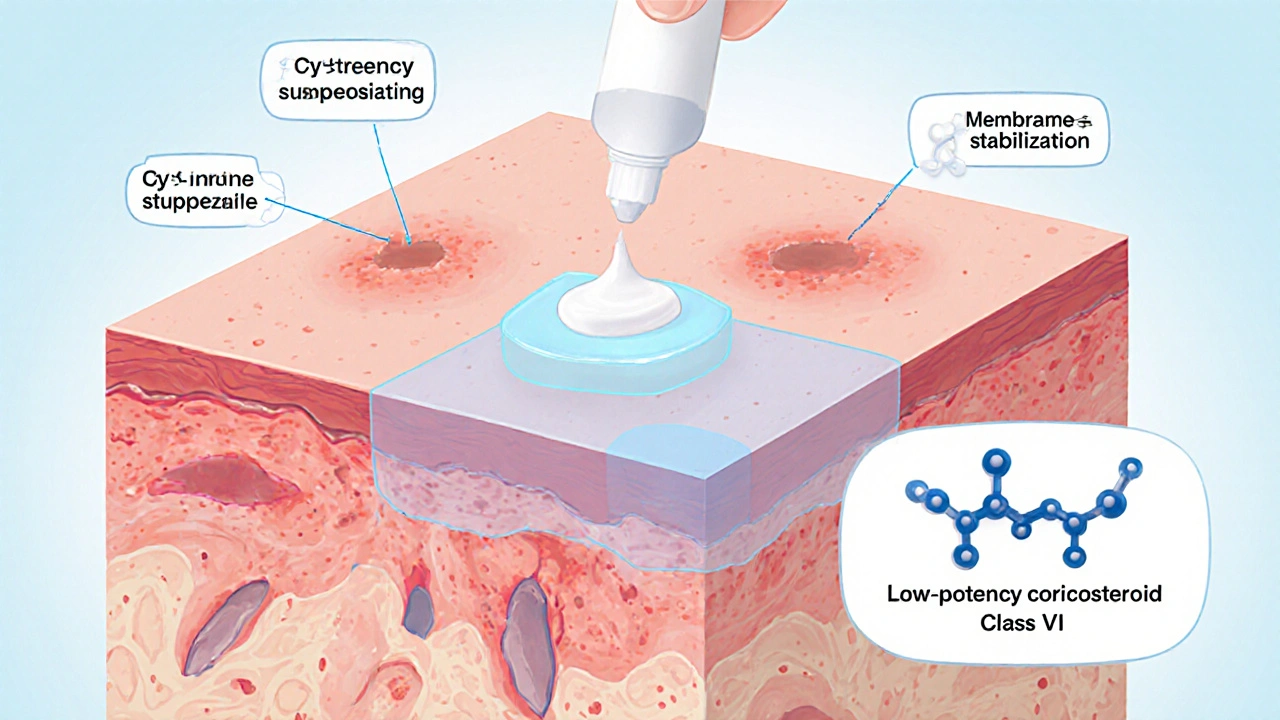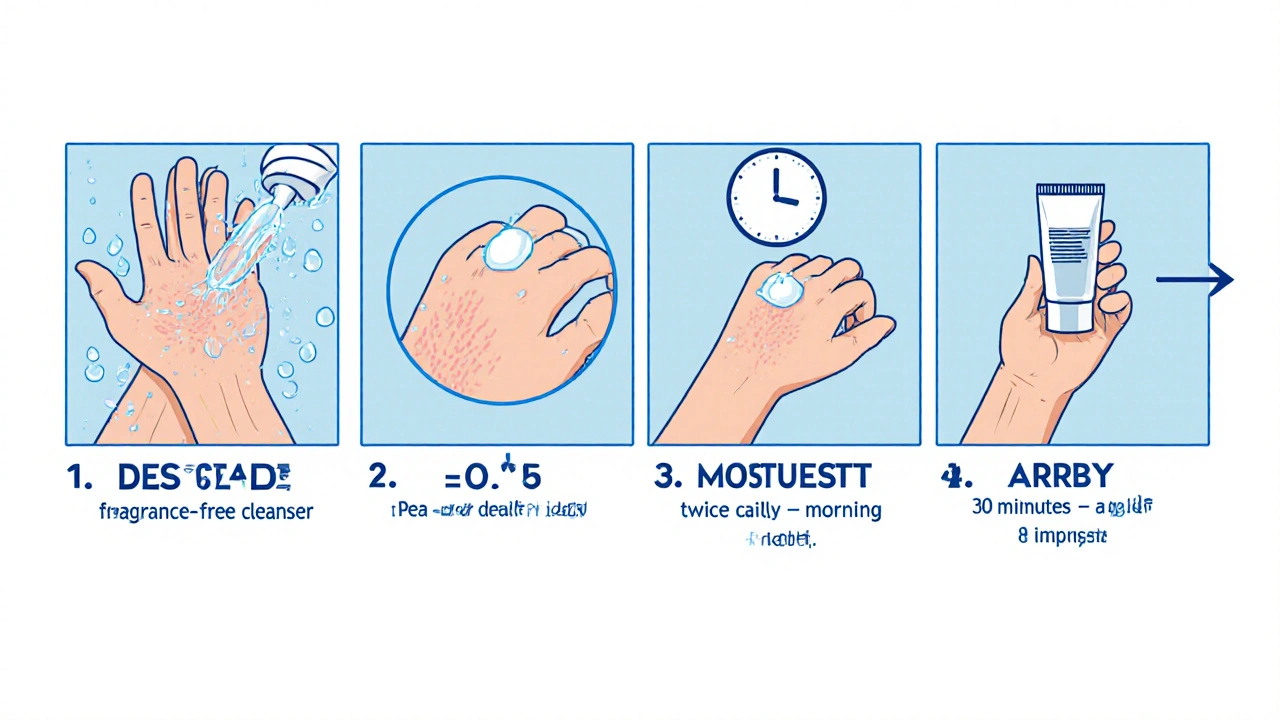How Desonide Treats Contact Dermatitis: Benefits, Usage, and Safety
 Oct, 16 2025
Oct, 16 2025
Desonide Application Amount Calculator
How Much Desonide Cream Should You Apply?
This tool estimates the appropriate amount of Desonide cream based on the size of your affected area, following clinical guidelines.
Small Area
About the size of a 10-cent coin (1.8 cm diameter)
Approx. 0.5 g (1 pea-sized amount)
Medium Area
About the size of a quarter (2.4 cm diameter)
Approx. 1.0-1.5 g (2-3 pea-sized amounts)
Large Area
About the size of a golf ball (4.3 cm diameter)
Approx. 2.0+ g (4+ pea-sized amounts)
Please select an area size to see your application amount.
Key Takeaways
- Desonide is a low‑potency topical corticosteroid ideal for mild‑to‑moderate contact dermatitis.
- It works by suppressing the inflammatory cascade without the high‑risk side effects of stronger steroids.
- Apply a thin layer twice daily on clean, dry skin and combine with moisturizers for best results.
- Short‑term use is safe for most adults; children and pregnant women need extra caution.
- When symptoms persist beyond two weeks, revisit your clinician for a possible treatment switch.
What Is Desonide?
When treating itchy skin, Desonide is a low‑potency topical corticosteroid that helps reduce inflammation and redness. First approved by the FDA in 1975, it belongs to the class of synthetic glucocorticoids that mimic the body’s natural cortisol. Because of its gentle strength (usually classified as Class VII on the potency scale), dermatologists often prescribe it for sensitive areas such as the face, folds, and pediatric skin.
Understanding Contact Dermatitis
Contact dermatitis is an inflammatory skin reaction triggered by direct exposure to irritants or allergens. Common culprits include nickel, fragrances, poison ivy, and certain soaps. The reaction typically appears as red, itchy patches that may blister or weep. While the condition is not life‑threatening, prolonged inflammation can damage the skin barrier, leading to chronic dryness and secondary infection.
How Desonide Works in Contact Dermatitis
Desonide targets the key steps of the inflammatory pathway:
- Inhibits cytokine release: It suppresses tumor necrosis factor‑alpha (TNF‑α) and interleukins that drive redness.
- Stabilizes cell membranes: By reducing phospholipase A2 activity, it limits prostaglandin formation.
- Reduces leukocyte migration: Fewer immune cells reach the skin surface, easing itching.
The result is a calmer skin surface with less scaling and faster healing. Because Desonide’s potency is low, it achieves these effects without triggering the skin‑thinning (atrophy) often seen with stronger steroids.

When to Use Desonide
Desonide is best suited for:
- Mild‑to‑moderate contact dermatitis on the face, neck, or intertriginous zones.
- Children older than 6 months where stronger steroids could affect growth.
- Patients who have previously reacted to higher‑potency steroids.
- Short‑term flare‑ups (usually 1‑2 weeks) in adults.
If your rash involves deep ulceration, extensive oozing, or covers large body areas, a medium‑potency steroid such as hydrocortisone 1% or a prescription‑only option may be required.
How to Apply Desonide Correctly
- Wash the affected area gently with a fragrance‑free cleanser and pat dry.
- Apply a pea‑sized amount (about 0.5g) to each lesion. A thin, even film is all you need.
- Rub it in gently; avoid excessive rubbing, which can irritate the skin.
- Use twice daily-once in the morning and once before bedtime.
- After the prescribed course (usually 7‑14days), stop abruptly rather than tapering, because the drug’s low potency carries minimal rebound risk.
- Complement the treatment with a bland moisturizer (e.g., petrolatum or a ceramide‑rich cream) to restore barrier function.
Remember: the “more” principle does not apply to steroids. Over‑application can still result in local side effects, especially on thin skin.
Potential Side Effects and Safety Concerns
Even low‑potency agents have a safety profile you should know:
| Side Effect | Incidence | Management |
|---|---|---|
| Skin irritation or burning | Rare (<1%) | Discontinue; consider a non‑steroidal barrier cream. |
| Contact allergy to the cream base | Very rare | Patch test; switch to a preservative‑free formulation. |
| Hypopigmentation | Uncommon | Limit use to affected spots; avoid prolonged daily application. |
Systemic effects such as adrenal suppression are exceedingly uncommon with Desonide because less than 0.5% of the dose is absorbed. However, caution is advised for:
- Infants under 6months-use only under specialist guidance.
- Pregnant or breastfeeding individuals-though animal studies show no teratogenicity, clinicians usually reserve use for severe cases.
- Patients with pre‑existing skin infections-steroids can mask infection signs.
If you notice thinning skin, stretch marks (striae), or a persistent rash after stopping Desonide, contact your healthcare provider.
Comparing Desonide with Other Topical Steroids
| Agent | Potency Class | Typical Indication | Typical Side‑Effects |
|---|---|---|---|
| Desonide | Class VII (low) | Mild facial or intertriginous dermatitis | Rare irritation, mild hypopigmentation |
| Hydrocortisone 1% | Class VII‑VI (low‑moderate) | Generalized mild eczema, insect bites | Skin atrophy with prolonged use |
| Clobetasol propionate 0.05% | Class I (super‑potent) | Severe plaque psoriasis, thick lichenified eczema | Atrophy, telangiectasia, systemic absorption |
From the table you can see why Desonide shines in the “gentle but effective” niche. It offers enough anti‑inflammatory power for contact dermatitis without the higher‑risk profile of medium‑ or high‑potency steroids.
Practical Tips to Maximize Success
- Identify the trigger: Stop using the suspected irritant or allergen as soon as possible.
- Patch test: If you’re unsure what’s causing the rash, an allergist can perform a patch test to pinpoint the culprit.
- Combine with barrier repair: Apply a fragrance‑free moisturizer within 30minutes after the steroid to lock in moisture.
- Track progress: Take photos or keep a simple diary of symptom severity over the treatment course.
- Know when to quit: If after 14days there’s no noticeable improvement, see your clinician for alternative therapy.
Frequently Asked Questions
Can I use Desonide on my face?
Yes. Desonide’s low potency makes it one of the safest steroids for facial skin, which is thinner and more prone to atrophy. Apply a thin layer twice daily and stop once the rash clears.
How long should I treat contact dermatitis with Desonide?
Most guidelines recommend a 7‑ to 14‑day course. If symptoms improve quickly, you can stop after a week. If there’s no change after two weeks, consult your doctor.
Is Desonide safe for children?
It’s approved for children older than 6months. Because absorption is low, growth‑related side effects are rare, but always follow your pediatrician’s instructions.
What should I avoid while using Desonide?
Avoid applying over large open wounds, oily acne lesions, or fungal infections without medical advice. Also, skip other topical steroids on the same area to prevent cumulative irritation.
Can I combine Desonide with a moisturizer?
Absolutely. In fact, using a bland emollient after the steroid helps restore the skin barrier and can reduce the need for re‑application.
Desonide fills a niche that many patients with contact dermatitis need-effective inflammation control without the baggage of stronger steroids. By understanding when and how to use it, you can keep your skin calm, clear, and ready for daily life.
Johnpaul Chukwuebuka
October 16, 2025 AT 18:17Desonide can be a gentle ally for anyone dealing with itchy skin, especially in hot climates where the skin gets extra stressed. Using it twice a day keeps the rash calm without harsh side effects. Pair it with a simple moisturizer to protect the barrier and you’ll feel relief quickly.
Xavier Hernandez
October 21, 2025 AT 12:17It is a moral duty to choose low‑potency steroids like Desonide over their stronger cousins, lest we gamble with skin thinning and other nasty consequences. The bright, calming effect on inflamed patches is a testament to responsible dermatologic care. Those who ignore this wisdom risk turning a mild rash into a chronic nightmare.
ANTHONY COOK
October 26, 2025 AT 05:17America’s skin deserves the best protection, and Desonide is the smart, home‑grown choice 😤. Any foreign‑made steroid that promises faster results often hides dangerous side‑effects. Stick to what works and keep the skin great.
Sarah Aderholdt
October 30, 2025 AT 23:17Desonide’s low potency makes it suitable for delicate areas without compromising safety. Apply sparingly and observe the improvement within days.
Phoebe Chico
November 4, 2025 AT 17:17Think of Desonide as a gentle whisper that calms the fiery tantrum of dermatitis, wrapping the skin in a soothing embrace. It respects the body’s own rhythm while easing the itch, a true ally in the battle against irritation.
Larry Douglas
November 9, 2025 AT 11:17Desonide functions by inhibiting cytokine release which reduces inflammation and redness; its low potency minimizes atrophy risk; clinicians prefer it for facial eruptions because it balances efficacy and safety. The recommended regimen involves a pea‑sized amount twice daily for up to two weeks. Patients should avoid excessive application to prevent local side effects. Always consult a dermatologist if the rash persists.
Adam Stewart
November 14, 2025 AT 05:17For those who are cautious about steroids, Desonide offers a gentle alternative. Applying it modestly while keeping the skin hydrated can make a noticeable difference.
Selena Justin
November 18, 2025 AT 23:17It is advisable to incorporate a bland moisturizer after each Desonide application to restore the lipid barrier. Monitoring the treated area for any signs of irritation ensures safe usage.
Raghav Suri
November 23, 2025 AT 17:17Avoid overt rubbing; it can worsen irritation.
Freddy Torres
November 28, 2025 AT 11:17Desonide’s subtle strength dances lightly on the skin, easing inflammation without drama. Use it wisely and let the skin breathe.
Andrew McKinnon
December 3, 2025 AT 05:17Sure, slather on a high‑potency steroid and hope for miracles, or you could just opt for Desonide and actually understand the pharmacodynamics. The latter avoids the circus of side‑effects while delivering measurable outcomes. It’s a no‑brainer for practical clinicians. Let’s keep the hype in check.
Dean Gill
December 7, 2025 AT 23:17Desonide, a class VII topical corticosteroid, occupies a niche that bridges the gap between over‑the‑counter hydrocortisone and the more aggressive prescription‑only options. Its molecular structure allows sufficient penetration to the epidermis while avoiding the deep dermal absorption that leads to systemic effects. For patients with contact dermatitis, the primary therapeutic goal is to dampen the inflammatory cascade quickly and safely. By inhibiting phospholipase A2, Desonide reduces the synthesis of prostaglandins, which are key mediators of redness and swelling. Additionally, the drug suppresses the transcription of cytokines such as TNF‑α and interleukin‑1, further curbing the immune response. Clinical studies have consistently shown that twice‑daily application of a pea‑sized amount leads to noticeable symptom relief within 48‑72 hours. The low‑potency nature translates to a markedly reduced risk of epidermal thinning, telangiectasia, or hypothalamic‑pituitary‑adrenal axis suppression. Nevertheless, practitioners should counsel patients to limit use to a maximum of two weeks unless re‑evaluation dictates otherwise. In pediatric populations older than six months, Desonide remains one of the few steroids that does not interfere with growth when used appropriately. Pregnant patients may also benefit, though a risk‑benefit discussion is essential given the limited data. Combining Desonide with a ceramide‑rich moisturizer restores the lipid barrier, which often becomes compromised during flare‑ups. This combination not only mitigates transepidermal water loss but also creates a protective seal that prolongs the steroid’s effect. Patients should be instructed to avoid occlusive dressings unless specifically directed, as these can increase percutaneous absorption. If after the prescribed course the rash persists or worsens, escalating to a medium‑potency steroid or investigating alternative diagnoses is prudent. Ultimately, Desonide offers a balanced approach: effective anti‑inflammatory action with a safety profile that makes it suitable for sensitive areas like the face, intertriginous zones, and even some pediatric cases.
Royberto Spencer
December 12, 2025 AT 17:17One might argue that the pursuit of flawless skin is a metaphysical quest, yet Desonide provides a pragmatic stepping stone toward that ideal. By respecting the skin’s natural equilibrium, it honors both science and the patient’s dignity. Those who dismiss its modest potency overlook a subtle but powerful truth.